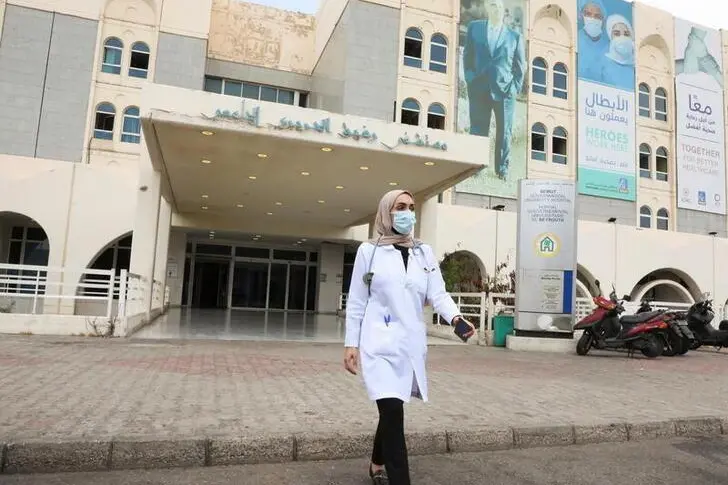PHOTO
BEIRUT: Lebanese Hospital Geitaoui UMC was one of three major hospitals in Beirut knocked out by the mammoth explosion in the port last August that catapulted the city into a disaster zone in seconds.
All this car park area was filled with the wounded; 300 wounded and 12 corpses. 12 bodies, some of them were unidentifiable because they were incinerated - from the port.
Dr. Naji Abi Rached, cardiologist and medical director at the hospital, which is situated just 1,200 meters from the epicenter, was speaking to The Daily Star from his relocated office on the hospitals second floor, the original having been "totally destroyed.
So, all this space was filled with wounded and dead people and we had to do major operations here, like craniotomy (opening of the head) with any means that were available, he said, pointing out the window to the ground floor emergency ward and car park.
All patients were saved but it was hell, Rached said, recalling the day almost exactly a year on from the disaster.
On Aug. 4 2020, Beirut was plunged into pandemonium when hundreds of tons of ammonium nitrate, a highly explosive fertilizer, exploded having been stored carelessly in a warehouse in the port. Over 200 people died, 6,500 were wounded and large portions of the capital were demolished as the nuclear-like blast swept through homes and businesses.
Rached explained that at Lebanese Hospital Geitaoui, an emergency plan is in place for catastrophes. "We have a plan, which we call white plan, plan blanc. It's a plan that we preview for catastrophes and it has many steps.
Despite having trained many times for a disaster, the plan did not take into consideration that the hospital and staff would be victims too. But even with the plan, the plan could not work as predicted because we were overwhelmed, we did not imagine that the hospital itself would be hit.
The eight-floor hospital suffered widespread destruction, ceilings caved in, pulling down electrics and wires. Windows shattered, spraying glass onto anyone near as individuals were thrown across the floor and equipment collapsed onto patients in bed, Rached explained.
Some 17 elevators of the hospitals were all blown, all the infrastructure inside the hospital was knocked out. It was declared nonfunctional as soon as the blow hit.
The 120 patients already at the hospital had to be evacuated, proving particularly challenging for the coronavirus ward and crucial need for isolation.
With the elevators out of action, hospital staff carried patients on their backs down flights of stairs, who were then transferred by the Lebanese Army and Red Cross to hospitals outside Beirut.
Photographs taken from the time depict scenes of chaos. The emergency rooms walls and floors are covered with blood and debris, while injured men, women, and children sit on the floor, slumped against the wall with empty shocked expressions, as frantic doctors and nurses treat people.
One part of the plan blanc operation that was successfully implemented was recruiting specialists to the hospital from across Lebanon for urgent assistance. On the same night, doctors arrived from Byblos and Metn, navigating through Beiruts traffic and debris-blocked streets either by foot or scooter, Rached said. We managed to build a team of 20 to 22 specialized doctors, on top of the resident staff all that same night.
It was a hell of a night - when you close your eyes and think of it, if you go back to this day, it's really devastating. It's brain damage.
Rached believes the late in the day timing of the explosion, 6:07 p.m., spared lives, as staff from severely wrecked departments had finished shifts. Happily, we did not have any deaths at the hospital, from the hospital staff and personnel. But we had many wounded, mild and moderate, not severe.
Today, 12 months on the hospital is 80 percent functional, and we have the will to survive, Rached concluded. The institution suffered costs estimated at $10 million, as well as subsequent businesses losses at $15 million, according to Rached.
Thanks to local NGOs, INGOs, and a donation from the Vatican in Rome, but not a penny from the Lebanese government, repairs began two days after the explosion and continue a year on. Rached hopes by October all reconstruction work will have been completed.
Yet since last August, conditions for hospitals in Lebanon have only worsened against the countrys severe financial crisis, which has left the health sector juggling medicine shortages, debt and an exodus of doctors and nurseswith little stability and government support in sight.
And just as the populations need for health care grows, not only with the COVID-19 pandemic but also with Lebanons deteriorating living conditions, the future remains alarmingly uncertain for the medical sector.
Copyright 2021, The Daily Star. All rights reserved. Provided by SyndiGate Media Inc. (Syndigate.info).












